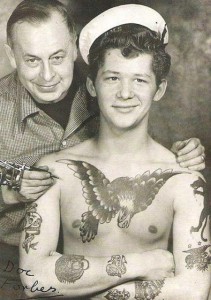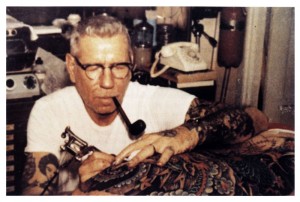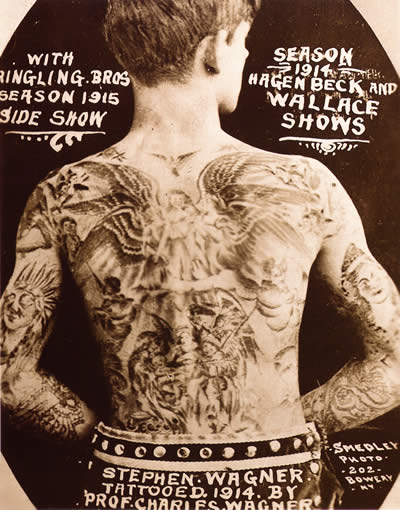Tattoo History
Tattoo Facts Describing Tattoo History
The History of Tattoos
A debate about tattoo history can never be fully settled since permanent tattoo makeup dates back over 5,000 years ago. According to Wikipedia’s tattoo history section, “Tattooing has been a Eurasian practice at least since around Neolithic times. In 1991 Ötzi the Iceman, dating from the fourth to fifth millennium BC, was found in the Ötz valley in the Alps and had approximately 57 carbon tattoos consisting of simple dots and lines on his lower spine, behind his left knee, and on his right ankle.” Searching for tattoo history in Egypt unearthed mummies with tattoos on their bodies resembling animals and monsters dating back to about 2,400 years ago. These ancient tattoos are believed to be decorative with and meant to portray the status of the individual preserved in tattoo history.
Past tattoo history and tattooing in the Western Hemisphere as it exists today originated from Polynesia and in the discovery by eighteenth century explorers and European Sailors. The word “tattoo” has said to have been derived from the Polynesian word ‘ta’ which means striking something and the Tahitian word “tatau” which means “to mark something”.
In the United States and North America, early Jesuits report of Native Americans tattooing tribesmen to reflect status and warrior accomplishments. Before the 1900’s in the US, tattoos had a negative association by most people and tattooed individuals were often regarded as “freaks” seen in carnival attractions. In 1846, the first tattoo shop opened in New York by Martin Hildebrandt, USA’s first professional tattoo artist, and began tattooing men in the military on both sides of the Civil War. Hildebrandt was also responsible for tattooing America’s infamous first “tattooed lady” or “tattoo wonder” with the Barnum and Baileys Circus, who happened to be his daughter Nora. This was all 45 years before the Samuel O’Reilly invented the first electric tattooing machine in 1891 and changed tattoo history forever.
“A sailor without a tattoo is like a ship without grog; not seaworthy” – Sam O’Reilly
Just as tattoo history has evolved, tattooed perceptions have provoked different feelings throughout the history of tattoos.
- 1750 – 1900 – In early tattoo history tattoos had a very negative perception and were mostly seen at carnival freak shows. People hoping to catch a glimpse of tattoo history during this time usually found them at the circus. In 1804 Jean Baptiste Cabri who had been tattooed by the Marquesas became the first tattooed carnival performer. Unfortunately by 1822 he had passed away, poor and forgotten…until now when someone revels in tattoo history.
- 1900 – 1950 – Tattoos indicated that the person was either a sailor or a marine in early 20th century tattoo history. In these times the tattoos did not carry social stigma so much but were meant to remember or bond a group together. Most of these tattooed men generally indicated that they were enlisted men and drawn to indicate military units, battles, kills, etc., but few Navy or Marine officers dared to tattoo their body. Life magazine estimated in 1936 that 10 million Americans or approximately 6% of the population had at least one tattoo. Sailor Jerry, one of America’s most popular tattoo artists, was born in 1911 and his influence and designs continue to influence modern tattoos across many new merchandising mediums today.
- 1950 – 1960 – In the early 1950’s, tattoos became popular and widely associated with criminals, mostly outlaw bikers and social outcasts. It was during this time in tattoo history that tattoos began to get a really bad reputation. “Prison tats” became popular where having a tattoo indicated to some people that you were a tough, ignorant, convicted felon and you had no fear. It was here that the bad reputation for tattoos and tattoo prejudice may have been forever instilled in the minds of many of today’s older generations.
- 1960 – 1990 – In the 70’s “free love” reigned and some anti-war enthusiasts began to get peace sign tattoos which made one start to wonder if the perception of tattoos throughout tattoo history will begin to change to something more “peace-full”. However, a sudden hepatitis outbreak forced tattoo shops to close nation-wide. In 1961 tattooing became illegal in New York, a ban that lasted 36 years until recently in 1997 when a report by Dr. Benjamin Mojica published in the New York Times persuaded New York that the bill was “a clear waste of critical public health resources.”
- 1990-2012 – Tattoo history continues to unfold today as it seems every young person has a tattoo to share and tell. A 2008 Harris Poll shows an estimated 14% of Americans now have one or more tattoos, and most claim it makes them feel sexier. In 2011 Mattel toys introduced the first tattooed Barbie doll which, albeit to some controversy, has been accepted. This is contrary to the response Mattel saw in 1999 when they released the Butterfly Art Barbie. After too many parents complained the doll was removed from stores, but not from our tattoo history.
A 2006 a study done by the Journal of the American Academy of Dermatology found that 24% of Americans between 18 and 50 are tattooed; that’s almost one in four. And the survey showed that about 36% of Americans age 18 to 29 have at least one tattoo.
There are an estimated 20,000+ parlors operating in the United States, the most in tattoo history. According to a U.S. News & World Report article, on the average an tattoo studio is being added in the country every day. The article ranked tattooing as the sixth fastest growing retail venture of the 1990s, right behind the internet, paging services, bagels, computers and cell phones.
Today tattoos are no longer reserved for the circus. Recently tattoos have been more popular than we’ve ever seen in tattoo history. In 2010 around 2 in 5 people, about 38%, of Generation Y reported they had a tattoo. With such a rise in popularity in such a short amount of time, the odds that we would see a few bad tattoos throughout tattoo history was inevitable. In addition to tattoo mistakes, there have been many other reasons reported as to why more and more people also seek tattoo cover up options. The most popular ways to cover a tattoo include clothing or a tattoo concealer makeup.
Today, tattoo prejudice still exists within corporate America and our tattoo history has showcased many debates about tattoo acceptance. Besides the debate on tattoo safety New York faced, there’s been just as many debates on what is an appropriate tattoo and today many tatted individuals are forced to cover up tattoos for work. The criteria for judging what is an acceptable tattoo continues to change according to the public’s perception, but people’s personal opinions have not always been forgiving throughout our history of tattoos. Another discerning factor in tattoo prejudice is that there is a clear and direct correlation between how income, education level and the percent of those people who have tattoos. Studies in recent tattoo history continue to show that tattoos are more popular among the poor and under educated.




















